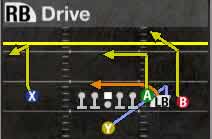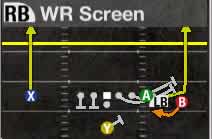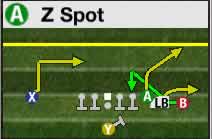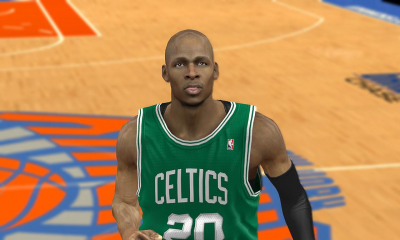

Welcome back to NCAA Football 09 Passing 101. I hope you enjoyed your recess.
I thoroughly enjoyed your comments and reactions to Part 1 earlier this week. I always appreciate that you fine folks actually read my ramblings and think enough to post your own thoughts which, by large, are more coherent and put together than mine.
A couple of you noted the relative ease of passing the ball in NCAA 09. I agree, especially when 09 is placed side by side to its predecessor, NCAA 08. The wide-open game play has rendered CPU-controlled defenses useless against the aerial attack. However, the inspiration for these strategy articles was drawn from facing human opponents, an activity that will likely increase for all of us with the inclusion of online dynasty mode. Human opponents, although often simplistic in defensive playcalling, are much more astute at recognizing patterns in your game. By manually placing a linebacker or safety in your favorite throwing lanes, a living, breathing opponent can be quite successful at thwarting your typical passing attack.
Thus, my main strategy has always been to have a progression. I have taken this a step further in recent years, creating altered progressions depending on what defense I happen to be facing. Although I am certainly no Peyton Manning at the line, combining a progression with play recognition can make you nearly unstoppable even against the most skilled of human players.
Tips for Reading Defenses
O.S.’er cbc72 posed an interesting request to Passing Strategy Part 1:
“I think though that helping people read what defense they are up against, especially giving some pre-snap tips would be useful. Also, what cues do people look at immediately after the snap to clue them in as to the defense they are facing?”
You stole my thunder a bit, cbc72 because that’s exactly what I was preparing to do for this article. I will admit that I have not spent enough time to spot the visual cues for all defenses in NCAA 09, I have spent enough time to recognize some of the basic giveaways.
The Cover 2 is one of the most easily recognized zone coverages, which is convenient as it is also one of the most frequently run defenses, especially by human opponents. Unfortunately there is no definite pre-snap cue of the Cover 2, but it is the most readily spotted coverages just after the snap. Look right up the middle at the safeties and linebackers. When in a Cover 2 scheme, the safeties will split and drop back at 45 degree angles, essentially dividing the deep secondary in two halves. The linebackers (or nickel/dimebacks, depending on formation) will fan out, as to cover the medium middle of the field. It may sound complicated, but once you see it a couple of times, it will stick in your brain.
The Cover 3 is a bit more difficult to spot. The basic principle of the defense is to safeguard against the deep ball by dividing the deep zone responsibility three ways, between the two corners and the free safety. It is hard to spot post-snap, but thankfully, 09 has installed a clever little pre-snap tell for this defense. Watch the corners. Often times, when in a Cover 3 look, both cornerbacks will “bail out,” or drop back deeper, as to be in better position for the coverage. The strong safety will also creep up a tad, as to be better fit for his assigned zone. A good post-snap read is the two safeties. They will essentially split, one moving backward, the other moving slightly forward and to the middle. A quick glance to the corners will confirm or deny a classic Cover 3. It is a bit of a longer read, however, so keep a good eye out for the pre-snap, as it will let you hasten your progression.
Man coverages are generally given away pre-snap by linebackers and safeties moving subtly into better position to cover their assigned receivers. They will creep up slightly, or make a small shuffle step to the side. It is not always a true giveaway, however, as the CPU will at times falsely show man coverage. It is always easy to recognize on the snap, just from watching the linebackers. In a zone, ‘backers almost always strafe backwards. In man, however, they will run laterally. This is a swift and obvious read, and should not take more than a couple of plays to master.
Blitzes are similar to man coverage, in that they are sometimes shown fraudulently. Linebackers and defensive backs will creep up to the line, shoulders reared. Sometimes they will blitz, sometimes they won’t. The good news, is that once you become used to watching the defense’s movements on the snap, you will see blitzes immediately, with or without the pre-snap cues.
Now, for your reading pleasure, onto a few of my play-specific recommendations against the Cover 2, Cover 3, and blitz (4-3 Free Fire).
Receiver Definition Guide:
Flanker (FL) = B
Split End (SE) = X
H-Back = LB
Tight End (TE) = A
Halfback (HB) = Y

Drive vs. Cover 2
First Read – H-Back: While it is hard not to make the FL post your first read against the Cover 2, the shallow drag is open so quickly that it is hard to pass up as the first option. Down and distance are obviously key variables here, but looking short first is not bad against the Cover 2.
Second Read – Flanker: The deep post is the natural enemy of the Cover 2, as it assaults the soft spot between the safeties. This could easily be your first read on this play, but with the immediate opening for the H-Back, I like to make the FL the second option on this play unless I am in dire need of big yardage.
Third Read – Halfback: The delayed flat route is always a decent check-down, as it doesn’t quite reach the corner on the outside, and gives you a some room to run.
Additional Notes: Ignore the SE, as he will be nearly triple teamed, as he is the only receiving threat on the left side of the field.
Drive vs. Cover 3
First Read – H-Back: Similar to the Cover 2, the shallow drag route will be open quickly. Provided big yardage isn’t a necessity, thread the needle to the H-Back.
Second Read – Tight End: This route takes a little bit of time to develop, but if you wait long enough, your TE will find a hole between the linebackers. This is a great read if a human opponent jumps the drag with a linebacker.
Third Read – Halfback: Once again, my favorite check-down option. Those new open field moves make the short last-ditch throw even more dangerous.
Additional Notes: Avoid both WR’s on this play. Your FL will get swallowed up by the deep safeties, and the SE won’t find a hole on the hitch-out. If the Cover 3 presents itself, look to your less-flashy options.
Drive vs. Blitz (Free Fire)
First Read – Halfback: Even though your HB is technically on a delay route, he will smartly cut short his temporary blocking assignment and dart to the flat for quick hot read. Remember, quick throws beat the blitz.
Additional Notes: In all honesty, there really is not a clear-cut second or third option, as there are problems with all of the other routes. The H-Back will oft find himself tangled with a blitzing linebacker, impeding the shallow drag. The TE, FL, and SE all have relatively lazy routes, and take too long to develop against a heavy blitz. If you have the intestinal fortitude and the pocket presence wait for a second option, look deep to the FL on the post, as he presents your best option for a big gain.

Flanker Dig vs. Cover 2
First Read – Tight End: The shallow drag is always a solid option against the Cover 2. Just as in the previous play, it is open very quickly, and is a good primary option. Shallow routes are often ignored, which makes them so dangerous if properly executed.
Second Read- Halfback: Although the HB’s shallow out-route would normally be taken away by the corner in the Cover 2, this play causes the defense to react a tad differently. Because there is no immediate flat route for the corner, he will instinctively follow the FL down the field. By the time he recognizes the flat is left vulnerable, it will be too late. You should have plenty of open field to work with.
Third Read – Flanker: Look for the “primary” FL third. His route is slow to develop, and he is initially followed by the corner. He can find a window between the linebackers, but other opportunities will present themselves much sooner.
Additional Notes: Do not throw to either the SE or the H-Back. The Split end will once again fall victim to the triple team, the price of being on an island on the left-hand side of the field. The H-Back will find himself jammed by the outside linebacker against the ‘2, and will not find much daylight deep, as he is the sole solitary deep route.
Flanker Dig vs. Cover 3
First Read – H-Back: This is a fairly unique read, and one of my personal favorites.. Although this fly route will eventually get eaten up by the deep safety, it is a Cover 3 killer in its infant stage. Upon the snap, your H-Back will find a seam immediately as he reaches linebacker depth. There is a very brief moment when the MLB is out of position in front and to the left of the H-Back. A quick strike to the outside shoulder is an almost guaranteed 10-12 yards. Fair warning, be relatively certain that a Cover 3 is coming from the pre-snap read I mentioned earlier. The opening is so fast, that it will be gone if you rely on a post-snap I.D.
Second Read – Tight End: Once again, the shallow drag is a nemesis of typical zone coverages. Exploit at will.
Third Read – Halfback: Your HB will be open just before he reaches the far-outside of the flat. The outside linebacker will eventually cover him, but if timed correctly, your chief ball-carrier will make for a solid receiving option.
Additional Notes: Both WR’s are poor options here. The FL's dig route will get jumped by the strong safety while the split end will once again fall victim to a lopsided one-on-three battle.
Flanker Dig vs. Blitz (Free Fire)
First Read – Tight End: A quick route to the space vacated by blitzing defenders is just what the doctor ordered. If you are facing an opponent who uses the blitz as a crutch, burn him with plays like this all day long.
Second Read – Halfback: Once he gets past the tangle of humanity at the line of scrimmage, your HB will get great position on his defender, with a lot of green in front of him.
Third Read – Split End: The arcing corner route is one of the slowest developing routes in NCAA 09. However, against isolated man coverage, it is also one of the most successful. If you can hang tough in the pocket, look for a slightly lofted toss to the outside shoulder.
Additional Notes: The FL can get open, but is slow to develop and is much less rewarding of an option as the Split End on the opposite side. The H-Back on the fly does not offer a decent throwing lane, so steer clear.

WR Screen vs. Cover 2
First Read – Flanker: Kind of obvious on this one. You really only need look to the FL on the bubble-screen route here. The key for this play to work is all about the timing. Whatever you do, do not fire a bullet immediately after the snap. Take a few steps back and wait for your lineman to reach the outside to pick up the corner. For the best results after the catch, be start inside and allow your blockers to set up an adequate cut-back lane to the outside.
Additional Notes: Disregard the other routes on this play. They will typically be covered anyway. Any crease they may find in the coverage comes far too late, as the pass rush will have finished off your QB by then.
WR Screen vs. Cover 3
First Read- Flanker: Hands-down, this is my favorite play to exploit the Cover 3. If you anticipate a Cover 3 from either pre-snap reads or simply opponent habit, fire the ball immediately after the snap. This works best, in that the area in front of the FL is immediately vacated as the corner bails out to the deep third. The OLB has flat responsibility, and it normally takes him a few moments to reach his destination. Often times, he will tangle with your blockers before he reaches the outside. Waiting for the throw as you did against the Cover 2 is also okay, but requires more effort for yards after the catch than the immediate toss.
Additional Notes: Again, no alternative throwing lanes present themselves. Stick to the play’s design. Creatively is not always a good thing.
WR Screen vs. Blitz (Free Fire)
First Read – Flanker: Let me preface this by saying, when ever I read man coverage on this play, I tend to audible out. This is mainly because I threw far too many pick-sixes in NCAA 08 from this type of play. Still, a heavy blitz play like Free Fire can certainly be exploited by a play like this, as there is very little over-the-top help to speak of. They key here is to wait, and possibly drop back a little deeper than normal to buy a some time. Blitzing defenders will reduce the time you have to throw, and this play will only be effective against any man scheme if you allow your blockers ample time to position themselves outside. If your throw is successful, be prepared for big, big things. Since there is no safety over the top, you should have a wide-open lane up the sideline. All other defenders are tangled in man coverage, making their pursuit and closing less threatening.
Additional Notes: If you wait too long, you will not even have time to think about a second read. Firing to either the H-Back or the Split End is much to risky. If you ever feel uncomfortable about this play prior to the snap, I recommend that you audible out.

Z Spot vs. Cover 2
First Read – Flanker: The FL will move in motion and run a slant/hitch rout just underneath the linebackers. A great short-yardage, but high-percentage throw.
Second Read - Tight End: The TE will run a flag route, landing squarely in the weak spot of the Cover 2. If you are playing a human opponent, the motion-route of the Flanker is apt to capture their immediate attention, and thus drawing up a defender (probably the outside linebacker) up to take away the short option. Wait for just a moment, and hit your TE between the numbers for a first down.
Third Read – Split End: This dig route will take some time to develop, but will provide a nice throwing lane between the outside and middle ‘backers right after his break. If you are feeling jittery about the FL or TE, wait just a smidgen longer and look to your SE.
Additional Notes: Although I typically like the H-Back’s flat route as a check-down, do not throw it against the Cover 2, as the CB will be sitting on it.
Z Spot vs. Cover 3
First Read - H-Back: Provided you are not in a 3rd and very long situation, the first read against the ‘3 is the H-Back on the flat route. Once again, the flats are vacated at the snap, making them easy pickin’s for decent yardage.
Second Read – Tight End: Waiting just a few moments longer will allow your TE to find some daylight just beneath the deep corner. He will have to work through some tangles, but he will find a little bit of open field. Be quick about it though, as the CB will eventually creep up once he realizes there is no other deep threat in the area.
Third Read – Flanker: These little underneath routes are always good check-down reads, if you had not yet noticed that trend. A little soft spot beneath the linebacker coverage always nets a couple three yards.
Additional Notes: The SE’s dig route gets eaten up the strong safety, sideling up into the zone. Do not throw this route against the ‘3.
Z-Spot vs. Blitz (Free Fire)
First Read – H-Back: This one has to be very quick, as the H-Back only has good position on his assigned defender for a split second. If you see a blitz coming, once again, look for the quickest available release.
Second Read – Tight End: Again, man coverage with no safety over the top will make the deep areas of the field vulnerable. Make certain your TE has good position, and fire over the outside shoulder.
Third Read: Flanker: The very definition of a check-down. If all other options seem treacherous, tattoo your Flanker in the chest. More than likely he will be tackled immediately for a minimal gain, but at least the ball is moving in the right direction.
After all of this, the most important piece of advice I can impart is to give yourself options. Having a progression of reads and knowing the weaknesses of different defenses can take your passing game to a level you never thought possible, even if this year’s passing game is much easier than those previous.
You may not wish to reach my level of insanity, running my entire playbook in practice mode to get a feel for the best reads. Then again, you just might. I would recommend, however, spending at least some time in practice mode to learn the weaknesses of the different coverages, especially the Cover 2 and 3, simple defensive plays that many human players tend to gravitate to. Your completion percentage will thank you, and rest assured your online dynasty-mates will curse you. It’s a win-win.



